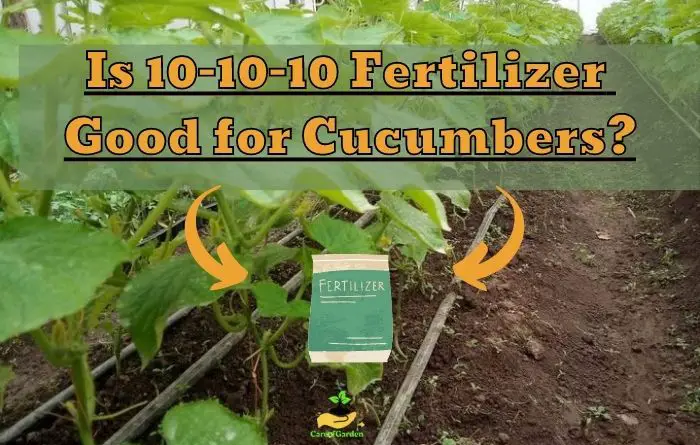Is 10-10-10 Fertilizer Good for Cucumbers? (Easy Answer)
Are you looking to grow healthy and delicious cucumbers in your backyard? If so, you may be wondering what kind of fertilizer to use. One popular choice is 10-10-10 fertilizer, but is it actually good for cucumbers? In this post, we’ll explore the pros and cons of using 10-10-10 fertilizer for your cucumber plants.
10-10-10 fertilizer can be suitable for cucumbers, but it’s important to understand the pros and cons before using it. The benefits of 10-10-10 fertilizer include promoting overall cucumber plant health, stimulating leaf and stem growth, and improving fruiting. However, excessive use of 10-10-10 fertilizer can lead to over-fertilization and cause damage to the plant. Before using 10-10-10 fertilizer on cucumbers conduct a soil test to determine the specific requirements of your cucumbers.
Is 10-10-10 Fertilizer Good for Cucumbers?
While 10-10-10 fertilizer can provide the necessary nutrients for cucumber plants to grow, it may not be the most optimal choice for achieving maximum growth and yield.
From my experience, during the early stages of growth, cucumbers need a lot of phosphorus to develop it’s roots compared to nitrogen. When cucumbers start growing their leaves, they will require nitrogen. As they transition to the flowering and fruiting stages, potassium becomes more crucial for promoting flower production and fruit development.
For the best results, I recommend using a fertilizer with a higher ratio of phosphorus and potassium during the respective growth stages. By doing so, you can better meet the changing nutrient needs of your cucumbers.
However, if a soil test reveals deficiencies in all three nutrients, a balanced fertilizer like 10-10-10 can be used in moderation to provide a well-rounded nutrient supply.
It is very important to follow the instructions on the fertilizer label in order to avoid over-fertilization, which can lead to potential damage to your cucumbers.
| Situation of Cucumbers | NPK 10-10-10 Requirement |
|---|---|
| Balanced nutrient levels | Yes |
| Vegetative growth stage | Yes |
| Flowering and fruiting stage | Yes |
| Soil test indicates nutrient deficiencies in nitrogen, phosphorus, and potassium | Yes |
| Soil pH is within the optimal range for cucumber plants | Yes |
| Soil organic matter content is low | Yes |
| High light intensity and temperature conditions | Yes |
| Poor soil fertility and nutrient availability | Yes |
| Newly transplanted seedlings or young cucumber plants | Yes |
| Rapid growth and high yield expectations | Yes |
Pros and Cons of 10-10-10 Fertilizer for Cucumbers
| Pros of 10-10-10 Fertilizer for Cucumbers | Cons of 10-10-10 Fertilizer for Cucumbers |
|---|---|
| Provides balanced nutrient supply | May lead to excessive foliage growth |
| Convenient and easy to use | Limited customization of nutrient ratios |
| Affordable and widely available | Potential nitrogen overload |
| Suitable for general garden use | Environmental impact and sustainability |
Benefits of Using 10-10-10 Fertilizer for Cucumbers
- Balanced Nutrient Supply: One of the first advantages of using a 10-10-10 fertilizer for cucumbers lies in its ability to provide a well-rounded mix of essential nutrients. Having a balanced ratio of nitrogen, phosphorus, and potassium, it will fulfill the general nutritional requirements of cucumber plants throughout various stages of growth.
- Ease of Application: Because of its pre-mixed composition it simplifies the process of measurement and application, saving valuable time and effort during the fertilization process.
- Availability and Affordability: The 10-10-10 is a widely available fertilizer that can be purchase at any garden centers and online stores. Also, its has a relatively affordable price compared to other types of fertilizer makes it a very cost-effective choice.
- Improving cucumber yield: The presence of phosphorus in 10-10-10 fertilizer can enhance fruiting and flowering in cucumbers, resulting in higher yield and quality of the produce.
Drawbacks of Using 10-10-10 Fertilizer for Cucumbers
- Potential Nitrogen Overload: Despite its balanced composition, 10-10-10 fertilizer does come with a potential downside – the risk of a nitrogen overload. Since nitrogen plays a vital role in plant growth, an excess of it could lead to a huge foliage growth at the expense of fruit production in cucumber plants. Monitoring nitrogen levels may prove necessary to avoid this issue.
- Limited Customization of Nutrient Ratios: Unlike customizable fertilizers, the fixed nutrient ratio in 10-10-10 fertilizer may not precisely match the specific needs of your cucumber plants or the unique characteristics of your soil. I prefer greater flexibility in customizing nutrient ratios to address specific deficiencies or imbalances effectively.
- Environmental Impact and Sustainability: If a 10-10-10 fertilizer is applied excessively or mismanaged, it can contribute to nutrient runoff, water pollution, and environmental harm. As responsible gardeners, we should use proper fertilization practices and explore eco-friendly alternatives to minimize such effects.
- Surface crusting and limited root absorption: The high salt content and granular form of 10-10-10 fertilizer can lead to surface crusting and limited nutrient uptake by the plant’s roots, especially in heavy or clay soils.
How to determine proper fertilizer ratios for cucumber plants
Follow these steps to determine the best fertilization ratio for cucumbers:
Step 1: Perform a soil test
Before you apply any type of fertilizer make sure to conduct a soil test to check your soil nutrients levels and pH. It will help you discover which nutrients are missing and which ones are abundant in the soil.
To do this use a soil test kit or send a soil sample to a professional testing lab for comprehensive analysis.
Step 2: Consider cucumber growth stage
Cucumber plants have varying nutrient requirements throughout their growth stages. During the vegetative stage, they need higher nitrogen levels for leaf development, while the flowering and fruiting stages require increased phosphorus and potassium for flower formation and fruit production.
Step 3: Choose the proper fertilizer
Based on the soil test you performed earlier and your cucumber growth stage requirements specified above, choose a fertilizer that has an appropriate NPK ratio. For example, a fertilizer with a ratio of 10-10-5 would contain 10% nitrogen, 10% phosphorus, and 5% potassium.
Step 4: Apply the Fertilizer Properly
Apply the fertilizer according to the guidelines provided on the packaging. Follow the recommended rates and methods of application to ensure proper nutrient uptake by the plants. Avoid over-fertilization, as this can lead to nutrient imbalances, environmental pollution, and plant damage.
Step 5: Monitor cucumber response
Check the health and growth of your cucumber plants after applying the fertilizer. If you notice any signs of nutrient deficiencies or excesses, such as yellowing leaves or stunted growth make small adjustments to the fertilizer ratios.
| Nutrient | Function | Sources of Deficiency |
|---|---|---|
| Nitrogen (N) | Stimulates leaf and stem growth, overall plant vigor | Stunted growth, pale yellow leaves |
| Phosphorus (P) | Promotes root development, flowering, and fruit production | Poor root growth, weak flowering, low fruit yields |
| Potassium (K) | Enhances disease resistance, supports overall plant health | Weak stems, leaf edges turning brown, low yields |
| Calcium (Ca) | Strengthens cell walls, aids in fruit development | Blossom end rot on fruits |
| Magnesium (Mg) | Assists in chlorophyll production and enzyme activation | Yellowing between leaf veins (interveinal chlorosis) |
| Iron (Fe) | Required for chlorophyll synthesis and energy production | Yellowing leaves with green veins (iron deficiency) |
| Manganese (Mn) | Enzyme activation and photosynthesis | Yellowing between leaf veins (interveinal chlorosis) |
| Zinc (Zn) | Involved in enzyme activity and hormone production | Stunted growth, yellowing leaves |
| Boron (B) | Aids in pollen germination and cell wall formation | Brittle or distorted growth, hollow fruit |
| Copper (Cu) | Facilitates enzyme function and carbohydrate metabolism | Wilting leaves, browning leaf tips |
How to Apply 10-10-10 Fertilizer to Cucumbers
1. Determine the right time to apply
Apply your 10-10-10 fertilizer during the vegetative growth stage, which typically occurs in the first four to six weeks after planting. This is the time when cucumber plants require more nutrients for healthy leaf development.
2. Calculate the amount
Check the packaging instructions on the 10-10-10 fertilizer for recommended application rates. As a general rule, use 1 pound of 10-10-10 fertilizer per 100 square feet of garden space.
3. Choose the method of application
a. Broadcasting: This method is suitable for larger areas. Scatter the fertilizer evenly over the soil surface around the cucumber plants. You can use a handheld spreader or simply sprinkle it by hand. Take care to avoid direct contact with the leaves or stems.
b. Banding: Choose this method if you prefer a more targeted application. Create a narrow trench or furrow next to the cucumber plants and apply the fertilizer directly into the trench, ensuring it is evenly distributed. Gently backfill the trench to cover the fertilizer.
c. Foliar spraying: Dilute the 10-10-10 fertilizer in water according to the recommended ratio on the packaging. Use a spray bottle or sprayer to apply the diluted fertilizer directly onto the foliage of the cucumber plants. This method allows for quick nutrient absorption through the leaves.
4. Water cucumbers
After applying the fertilizer, you need to water your cucumbers deeply to helps the nutrients penetrate the soil and reach the roots. Be cautious not to wet the leaves, as this can lead to disease.
5. Repeat as needed
Depending on your cucumber’s needs, you may need to apply 10-10-10 fertilizer every three to four weeks during the growing season. However, be careful not to over-fertilize, as it can harm the plants.
Frequently Asked Questions
10-10-10 fertilizer refers to a fertilizer that contains equal parts of three primary macronutrients: nitrogen, phosphorus, and potassium.
Yes, organic fertilizers or slow-release fertilizers can provide a balanced mix of nutrients and improve soil health without the risk of over-fertilization. Some examples of organic fertilizers include compost, fish emulsion, and bone meal.
Alternatives to 10-10-10 fertilizer include organic fertilizers, slow-release fertilizers, and specialized vegetable fertilizers that cater to the specific nutritional needs of cucumber plants.
No, cucumber plants have different nutrient requirements at different growth stages, and a fertilizer with a balanced NPK ratio may not meet those needs adequately.




